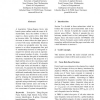Free Online Productivity Tools
i2Speak
i2Symbol
i2OCR
iTex2Img
iWeb2Print
iWeb2Shot
i2Type
iPdf2Split
iPdf2Merge
i2Bopomofo
i2Arabic
i2Style
i2Image
i2PDF
iLatex2Rtf
Sci2ools
EUSFLAT
2003
2003
Modeling high interest areas in descriptive TS fuzzy rule based systems
A descriptive Takagi-Sugeno fuzzy rule based system suffers under the curse of dimensionality since the number of rules is equal to a fuzzy system with a fully filled up decision table. By defining high interest areas as areas where the input space is covered with many membership functions to achieve an acceptable error, the consequence is an often inappropriate fine grid of membership functions in orthogonal arranged low interest areas and an exponential increased number of rules. A possible solution is that the fine grid of membership functions, originated by the projection of a high interest area on the concerning single input variables, is only used if all elements of the input vector are situated in a high interest area. To guarantee the interpretability of a descriptive fuzzy rule based system the additional membership functions caused by high interest areas should fit in the coarser grid by retaining the interpretability of all linguistic variables. This paper propose an a...
| Added | 31 Oct 2010 |
| Updated | 31 Oct 2010 |
| Type | Conference |
| Year | 2003 |
| Where | EUSFLAT |
| Authors | Ingo Renners, Adolf Grauel |
Comments (0)

